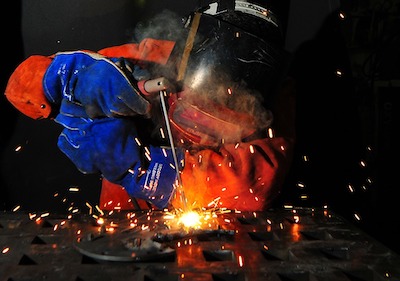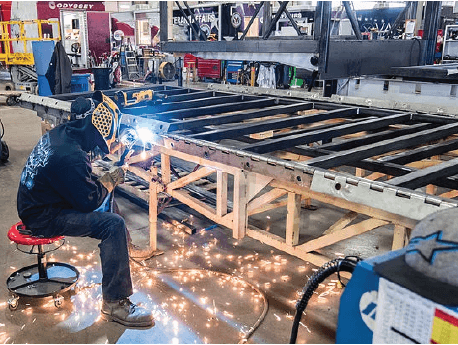All Regarding Welding: Trick Insights Into Techniques and Ideal Practices for Success
Welding includes a range of techniques, each suited for specific materials and applications. Comprehending these techniques, such as GMAW, SMAW, and TIG, is necessary for accomplishing ideal outcomes. The right equipment and safety and security methods can not be forgotten. As prep work and repairing play critical functions in the welding procedure, understanding these components can considerably improve the high quality of the end product. What are the vital variables that assure a successful weld?
Recognizing Different Welding Techniques
Welding techniques incorporate a selection of methods, each fit to specific applications and products. Amongst one of the most usual methods are Gas Steel Arc Welding (GMAW), Protected Metal Arc Welding (SMAW), and Tungsten Inert Gas Welding (TIG) GMAW, additionally referred to as MIG welding, is prominent for its speed and flexibility, making it perfect for thin materials. SMAW, or stick welding, is preferred for its simpleness and effectiveness in outdoor settings, particularly with thicker steels. TIG welding uses precision and control, making it appropriate for elaborate work and non-ferrous steels (Fabrication). Each strategy has its one-of-a-kind benefits and considerations, allowing welders to pick the most effective method based upon the job's requirements, material type, and preferred outcomes. Recognizing these methods is essential for effective welding
Essential Welding Tools and Tools
While various welding strategies call for particular abilities, the appropriate devices and devices are similarly necessary for achieving quality results. Crucial welding equipment consists of welding makers, which vary relying on the technique-- such as MIG, TIG, or stick welding. Protective equipment, consisting of handwear covers, headgears, and aprons, assurances security and convenience throughout the process. On top of that, fixtures and clamps assist safeguard materials in place, making sure accuracy in welds. Consumables like welding poles, cable, and shielding gas are additionally vital elements that affect the top quality of the weld. Furthermore, devices such as mills and cutters facilitate surface area preparation and post-weld ending up, adding to an expert end result. Purchasing high-quality equipment inevitably enhances the effectiveness and performance of welding projects.
Safety Practices in Welding
Correct safety practices are essential in the welding industry to shield workers from possible threats. Welders need to wear ideal personal safety equipment (PPE), consisting of safety helmets with appropriate shading, handwear covers, and flame-resistant garments. Ample ventilation is essential to decrease exposure to unsafe fumes and gases created during the welding process. Additionally, employees should be trained in the proper handling of welding tools to protect against crashes. Fire precaution, such as keeping combustible products away from the welding location and having fire extinguishers readily offered, are required. Routine inspections of equipment and workspaces can assist recognize prospective risks before they bring about mishaps. By sticking to these security practices, welders can develop a safer working setting and decrease threats connected with their trade.
Preparing Products for Welding
Preparing products for welding is a crucial action that greatly affects the high quality and honesty of the final item (Montana Mobile Welding and Repair Belgrade Welding). Correct preparation entails cleaning up the surface areas to get rid of pollutants such as dirt, rust, and oil, which can jeopardize the weld. Strategies such as grinding, sanding, or using solvents are generally employed to accomplish a tidy surface area. Furthermore, making sure that the materials fit with each other well is important; voids can lead to weak welds. It's additionally essential to think about the positioning and positioning of the parts, as this will affect the ease of welding and the last end result. Ultimately, selecting the proper filler material and making certain compatibility with the base metals is important for achieving solid, durable welds
Tips for Achieving High-Quality Welds
Achieving high-grade welds requires focus to detail and adherence to ideal practices throughout the welding process. Appropriate joint preparation is necessary, making certain surfaces are clean and free from pollutants. Selecting the proper filler material and welding technique based upon the base metals is important for suitable bonding. Maintaining regular travel speed and angle while welding can advertise and stop defects harmony. In addition, managing heat input is vital; too much warm can lead to warping and deteriorated joints. If necessary, on a regular basis evaluating the welds throughout the procedure enables for instant adjustments. Using proper post-weld treatments, such as cleansing and anxiety alleviation, can enhance the sturdiness and integrity of the weld, ultimately making certain a successful result.
Repairing Typical Welding Issues
Welding typically presents challenges that can affect the quality and honesty of the last item. Common issues such as porosity, inconsistent weld grains, and getting too hot can emerge, each needing specific fixing techniques. Comprehending these issues is crucial for welders to boost their skills and achieve suitable outcomes.
Porosity Problems Clarified
Although porosity can often be overlooked, it remains an important concern in welding that can compromise the stability of an ended up item. Porosity refers to the presence of tiny gas pockets within the weld grain, which can deteriorate the joint and lead to premature failing. This problem typically arises from contaminants, wetness, or improper securing gas protection during the welding procedure. To check here alleviate porosity, welders ought to confirm that the base materials are dry and tidy, use suitable shielding gases, and maintain constant welding criteria. Regularly inspecting the devices and setting can additionally assist recognize prospective concerns prior to they manifest in the weld. Attending to porosity efficiently is necessary for accomplishing strong, durable welds that fulfill quality criteria.

Inconsistent Weld Beans
Irregular weld beads can greatly impact the high quality and toughness of a finished item. Different aspects contribute to this concern, consisting of inappropriate traveling rate, inaccurate amperage setups, and inconsistent electrode angles. When the welder relocates also swiftly, a bead may appear narrow and do not have infiltration, while moving as well gradually can cause too much build-up. Furthermore, making use of the incorrect amperage can result in either undercutting or excessive spatter, both of which compromise weld stability. The welder's method, such as irregular lantern movement, can additionally cause unequal bead appearance. To mitigate these issues, welders ought to focus on preserving steady, regulated movements and guaranteeing correct equipment setups to attain uniformity in their welds. Uniformity is vital to accomplishing strong and reliable welds.
Overheating and Bending Issues
Extreme heat throughout the welding process can result in significant overheating and contorting concerns, influencing the structural honesty of the work surface. These issues frequently materialize as distortion, which can jeopardize positioning and fit-up, making additional assembly challenging. Elements adding to overheating consist of the selection of welding specifications, such as voltage and take a trip rate, as well as the sort of product being bonded. To reduce these problems, welders ought to preserve consistent traveling rate and proper warmth input while checking the work surface temperature level. In addition, preheating or post-weld warmth treatment can help ease anxieties created by fast air conditioning - Montana Mobile Welding and Repair Welding. Normal assessment and adherence to finest methods are important in preventing overheating and making certain the long life and reliability of bonded structures
Frequently Asked Concerns
What Are the Profession Opportunities in the Welding Sector?
The welding industry uses varied profession chances, including placements as welders, inspectors, teachers, and engineers. Specialists can work in production, building and construction, aerospace, and automobile sectors, taking advantage of solid demand and competitive salaries in different roles.
How Can I Improve My Welding Rate Without Sacrificing High Quality?
To enhance welding rate without sacrificing quality, one ought to exercise effective techniques, preserve tools, enhance settings, and boost hand-eye sychronisation. Routine training and seeking feedback can likewise considerably contribute to achieving faster, top quality welds.
What Certifications Are Available for Welders?
Numerous qualifications exist for welders, consisting of those from the American Welding Culture (AWS), the National Center for Construction Education And Learning and Research Study (NCCER), and numerous industry-specific organizations. These qualifications improve employability and demonstrate skill effectiveness.
Exactly How Does Welding Impact the Characteristics of Metals?
Welding influences the residential or commercial properties of steels by modifying their microstructure, which can bring about changes in firmness, toughness, and ductility. Heat input and cooling prices throughout the process greatly influence these product features.
Can I Weld Dissimilar Metals Together?
